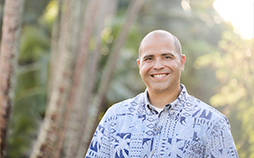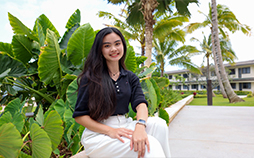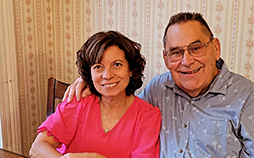Pursuing His Calling
January 2025
 Kahiamaikalani “Kahia” Walker, a BYU–Hawaii student from Laie, Hawaii, recalls, “I remember being in third grade during one of Iosepa’s voyages and watching it being launched. I remember thinking to myself, ‘I want to become a voyager.’” But it would be a decade until he voyaged on Iosepa, the wa‘a kaulua or traditional double-hulled voyaging canoe at the Polynesian Cultural Center (PCC) that is used as a “sailing classroom” by BYU–Hawaii for its Hawaiian Studies Program.
Kahiamaikalani “Kahia” Walker, a BYU–Hawaii student from Laie, Hawaii, recalls, “I remember being in third grade during one of Iosepa’s voyages and watching it being launched. I remember thinking to myself, ‘I want to become a voyager.’” But it would be a decade until he voyaged on Iosepa, the wa‘a kaulua or traditional double-hulled voyaging canoe at the Polynesian Cultural Center (PCC) that is used as a “sailing classroom” by BYU–Hawaii for its Hawaiian Studies Program.
Following high school, Kahia attended the University of Hawai‘i at Mānoa but soon realized it was not where he should be. He felt the Lord had different plans for him, though he did not know what they were, and he moved forward with faith by taking a break from school and making room for whatever was to come. Kahia was soon invited to join a voyaging canoe named Hōkūle‘a, where he literally learned the ropes of voyaging. “There was a lot of prayer involved at this time of my life and I just knew Heavenly Father was telling me not to go to school or get a job then because this opportunity to voyage was coming,” he explains.
The pieces continued to fall into place for Kahia to resume his voyaging training. He learned that BYU–Hawaii and PCC were making plans to get Iosepa voyaging for the first time in eight years to complete a month-long journey around Oahu. Kahia was asked to join with the restoration and launch of the canoe because of the skills he had developed. He began by helping with building a smaller-scale canoe to show what could be possible with the larger canoe.
“Once we built and tested the smaller canoe in the water successfully, people woke up and began to see that it was possible to bring Iosepa back as a functioning canoe,” says Kahia. “A big movement was started by the community to get the wa‘a back into the water.”
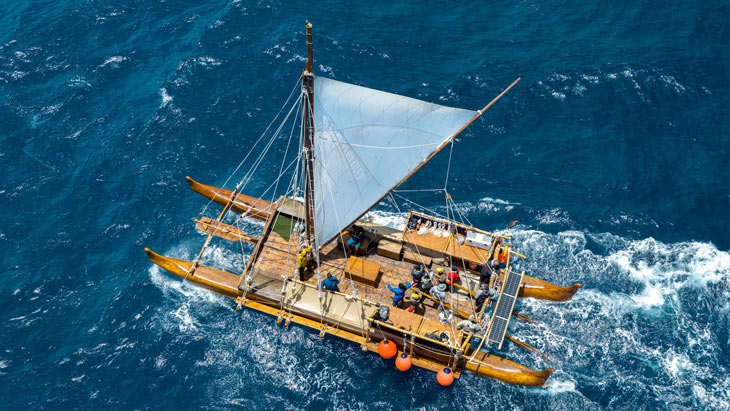
The process involved a year’s worth of restoration and preparation made by BYU–Hawaii students, PCC employees, community members, and volunteers, who refurbished the canoe down to the smallest detail. When Iosepa set sail in June 2024, the rotating crew of 60 people consisted of BYU–Hawaii students and alumni and other community members. During sailing, the 12 to 16 crew members on board at a time were picked up and dropped off along the docking points, giving those who joined the crew hands-on opportunities to learn voyaging, navigation, and cultural skills while connecting to Polynesian history.
Kahia’s roles on the ship included serving as watch captain, where he was second in command and made sure everything and everyone was functioning, and as quartermaster, where he oversaw all supplies on the ship, including lines, anchors, and safety and electrical equipment.
While docked at Honolulu, Kahia was invited to join a voyage to the Cook Islands with a canoe that needed another crew member. Within 24 hours, he was approved and moved to the new vessel, called Marumaru Atua. He spent 22 days at sea with an international crew and received incomparable training for deep-sea voyaging.
“The islands are not foreign to each other; we are all connected, and I understand now how voyaging unites people.”
– Kahia Walker
“My biggest takeaway from that experience is how a lot of the time the ocean can look like a barrier, but voyaging teaches that the ocean is a highway,” says Kahia. “The islands are not foreign to each other; we are all connected, and I understand now how voyaging unites people.”
He continues, “When I think of the Cook Islands, I can physically feel they are there. I’m not disconnected from them. I know now more than ever that we are all children of our Heavenly Father, and voyaging has strengthened this thought.”
Following the voyage, Kahia made the decision to attend school at BYU–Hawaii. Though he initially felt some trepidation, he received a scholarship and saw the ways the university was supporting him. “Because of these incredible voyages, I now recognize that I’m capable of making an impact on the world,” he says. “I’m grateful that I received a scholarship that is helping me pursue my passion and take it to the next level.”
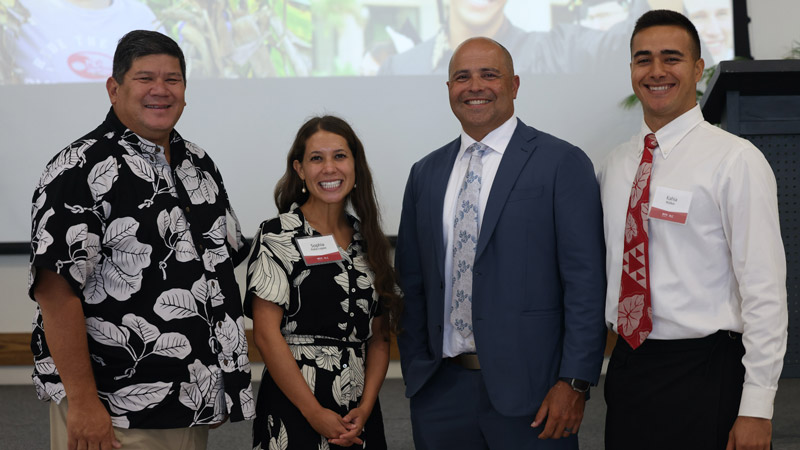
Kahia feels that voyaging is his calling in life and plans to make a career of it. To continue his path, Kahia is studying applied mathematics at BYU–Hawaii and plans to attend graduate school to study ethnomathematics, the study of math through cultural perspectives. Eventually, he hopes to captain a voyaging canoe and show others how connected they are to each other.
“Our voyaging ancestors were some of the smartest and most spiritually in-tune people to be able to navigate the ocean by the stars and islands alone,” says Kahia. “I know that because of what I’m learning at BYU–Hawaii, I’m able to voyage, connect with my ancestors, and make an impact on the world.”
 Kahiamaikalani “Kahia” Walker, a BYU–Hawaii student from Laie, Hawaii, recalls, “I remember being in third grade during one of Iosepa’s voyages and watching it being launched. I remember thinking to myself, ‘I want to become a voyager.’” But it would be a decade until he voyaged on Iosepa, the wa‘a kaulua or traditional double-hulled voyaging canoe at the Polynesian Cultural Center (PCC) that is used as a “sailing classroom” by BYU–Hawaii for its Hawaiian Studies Program.
Kahiamaikalani “Kahia” Walker, a BYU–Hawaii student from Laie, Hawaii, recalls, “I remember being in third grade during one of Iosepa’s voyages and watching it being launched. I remember thinking to myself, ‘I want to become a voyager.’” But it would be a decade until he voyaged on Iosepa, the wa‘a kaulua or traditional double-hulled voyaging canoe at the Polynesian Cultural Center (PCC) that is used as a “sailing classroom” by BYU–Hawaii for its Hawaiian Studies Program.

